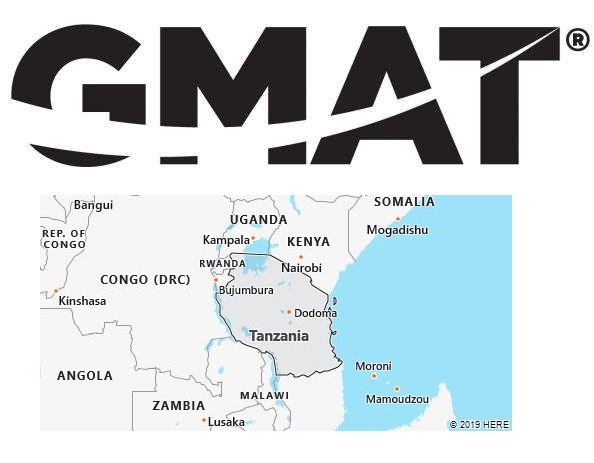GMAT Testing Location
We have found 1 GMAT test centre in Tanzania, located in Dar es Salaam. For specific test dates of 2019, please refer to the end of this page.

CATS TANZANIA LIMITED
RITA TOWER 16TH FLOOR
MAKUNGANYA STREET AND SIMU STREET
P.O.BOX 2569
255 Dar es Salaam
Tanzania
Phone: +255 22 2137915/8
Test Center Information
16TH FLOOR RITA TOWER
MAKUNGANYA STREET AND SIMU STREET
P.O.BOX 2569
DAR ES SALAAM TANZANIA
Email: info@imit.co.tz ;sales@catsgroup.co.tz
GMAT Exam Dates in Tanzania
Unlike some paper based exams, the GMAT is computer based. Therefore, there are no fixed test dates for GMAT. Wherever you are in Tanzania, all test centers are open from Monday through Saturday throughout the year. Some even offer the exam every day of the year. However, some test centers are not open on Sundays and national holidays. For example, most college-based test centers might be closed for extended periods around holidays. For precise testing dates in Tanzania, please visit test-maker website – https://www.mba.com/.
More about Tanzania
Politics
According to the constitution of April 25, 1977 (revised several times), Tanzania is a presidential republic with separation of powers, the separation of state and religion and guaranteed basic rights. The basic state order also guarantees the autonomous status of Zanzibar. The head of state, commander-in-chief of the armed forces and supreme owner of the executive is the Union President, who is directly elected for a period of 5 years (one-time re-election permitted). He has extensive powers, appoints the prime minister (appointment must be confirmed by parliament) and the other members of the cabinet, has the right to veto legislation and can dissolve parliament. J. Magufuli has been President of the Republic since 2015.
The legislature lies with the National Assembly (legislative period: 5 years) with a maximum of 394 members, of which 264 are directly elected by majority voting and up to 10 are appointed by the President. In addition, there are 113 women, the General Prosecutor ex officio and 5 representatives from Zanzibar through a quota system. Zanzibar has its own constitution, a house of representatives and an executive branch responsible for internal affairs. Its president is a member of the central government.
In terms of foreign policy, Tanzania focuses in particular on the regional environment, where it takes on a stabilizing and mediating position. In addition to its engagement in the East African Community, the country is also trying to play an active role in the Southern African Development Community (SADC), in the African Union ( AU ) and in the UN. In terms of security policy, v. a. the focus is on the participation in the MONUSCO peace mission in the Democratic Republic of the Congoand in the peace mission in Darfur / Sudan. Tanzania maintains close economic and development relations with the People’s Republic of China. There are border disputes with Malawi over the oil and gas-rich Lake Malawi.
National symbols
The national flag was first hoisted when the states of Zanzibar and Tanganyika were unified in 1964. It combines the flags of both countries in the color scheme. A yellow trimmed black stripe divides the flag diagonally. The resulting triangles are green (on the leech) and blue (on the flying end). Black stands for the people, yellow for the country’s wealth, green symbolizes the country, blue the sea and the island of Zanzibar.
The coat of arms, introduced in 1964, goes back to the coat of arms of the former Tanganyika. It shows in the center a Masai shield divided horizontally into four fields, which rests on a representation of Kilimanjaro; In the yellow uppermost field is the head of a torch of freedom, in the field below the national flag, in the following red field there are crossed axes and hatchets, in the lower silver field blue wavy bars symbolize Lake Tanganyika. The shield is covered with a spear on stakes. Heraldic shield holders are a man on the right and a woman on the left, each holding an elephant tusk. At the lower end of the overall picture, between the coffee and cotton plants, there is a banner with the motto “Uhuru na Umoja” (freedom and unity).
The national holiday is April 26th (Unification Day). It commemorates the creation of the United Republic of Tanzania in 1964.
Parties
In addition to the Revolutionary Party (also Chama Cha Mapinduzi, CCM; founded 1977, former unity party), numerous new parties were admitted after the introduction of the multiparty system (July 1, 1992), including the Civic United Front (CUF, founded 1992), the Party for Democracy and Progress (CHADEMA, founded in 1993), the Tanzania Labor Party (TLP, approved in 1993), the United Democratic Party (UDP, approved in 1994), the National Convention for Reconstruction and Reform (NCCR-Mageuzi, founded in 1992) and the Alliance for Change and Transparency (ACT, founded in 2014).
Unions
The umbrella organization is the Trade Union Congress of Tanzania (TUCTA). There is also the Zanzibar Trade Union Congress (ZATUC).
Military
The total strength of the conscript army (24 months of military service) is around 27,000 (2016), that of the paramilitary “Police Field Force” around 1,400. The army comprises around 23,000 soldiers and is essentially divided into five infantry brigades and one tank brigade, plus six artillery, two anti-aircraft, mortar and anti-tank battalions and one engineer battalion. The navy has about 1,000 and the air force 3,000 men.
